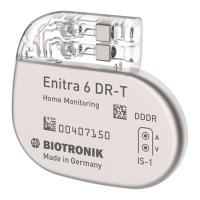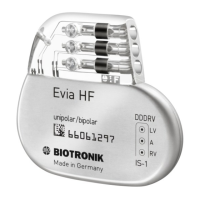Do you have a question about the BIOTRONIK Enitra 6 DR and is the answer not in the manual?
Defines the purpose and target patient population for the Enitra pacemaker system.
Details recommended pacing modes for different symptomatic conditions.
Explains the standardized lead connection types (IS-1, IS4) and compatibility notes.
Explains how telemetric communication is established with the programmer.
Details the functions of the programmer for testing and data management.
Lists the available pacing modes dependent on the individual diagnosis.
Describes the comprehensive therapy management system using Home Monitoring.
Explains data recording, impedance measurements, and IEGM display.
Details sensing, pacing thresholds, and timing adaptations for pacing.
Describes functions for resynchronizing ventricles and LV lead optimization.
Explains how devices recognize MRI fields and activate MRI programs.
Details automatic data transmission and initiated test messages for Home Monitoring.
Lists technical manuals providing usage information and care instructions.
States that the device and screwdriver are for single use and must not be reused.
Covers general complications like fluid accumulation, infections, and therapy ineffectiveness.
Lists potential technical failures such as lead dislodgement or component failure.
Discusses device sensitivity to EMI and BIOTRONIK's design for minimal susceptibility.
Explains asynchronous pacing during interference and magnet response to static fields.
Lists procedures like ultrasound and nerve stimulation that may harm the patient or device.
Warns about interference risks from external electrical sources and diagnostic procedures.
Explains potential device damage and lead tissue changes from external defibrillation.
Advises avoiding radiation therapy due to device damage risks and required precautions.
Warns about MRI risks due to magnetic fields and potential device damage or warming.
Lists required parts for implantation, including device, leads, and programmer.
Specifies essential components needed for the implantation procedure.
Stresses the importance of having a defibrillator available for emergencies.
Provides a step-by-step summary of the implantation process.
Advises on careful handling of set screws to prevent header damage.
Warns about open connector ports causing current flow and body fluid penetration.
Highlights the need for adequate lead spacing to prevent far-field sensing issues.
Details the process of connecting lead connectors to the device header.
Explains how to position the programming head for proper telemetry.
Describes the process and requirements for establishing wireless telemetry.
Explains that auto-initialization starts automatically after the first lead is sensed.
Reiterates the need for special precautions during device programming.
Advises performing a follow-up to ensure proper device system function post-initialization.
Details critical tests and patient monitoring during programming.
Warns against disconnecting telemetry modules during treatment.
Advises against setting risky parameter combinations and checking compatibility.
Recommends setting lead polarity only for bipolar leads to avoid issues.
Suggests using automatic sensitivity control for safety and avoiding manual settings.
Provides recommendations for setting sensitivity values based on standards.
Lists functions to prevent complications like PMT protection.
Details functions to prevent atrial tachycardia conduction to the ventricle.
Warns against unipolar pacing when an ICD is also implanted.
Outlines the procedure for conducting in-house follow-up using the programmer.
Provides estimates for remaining service times after ERI.
Explains PMT protection and VA criterion settings.
| Device Type | Implantable Cardioverter Defibrillator (ICD) |
|---|---|
| Manufacturer | BIOTRONIK |
| Telemetry | BIOTRONIK Home Monitoring |
| MRI Conditional | Yes |
| Defibrillation Energy | Up to 40 J |
| Therapy | Defibrillation, Pacing |
| Bradycardia Pacing Modes | DDD, VVI, AAI |
| Remote Monitoring | Yes (BIOTRONIK Home Monitoring) |
| Programming | BIOTRONIK Programmer |












